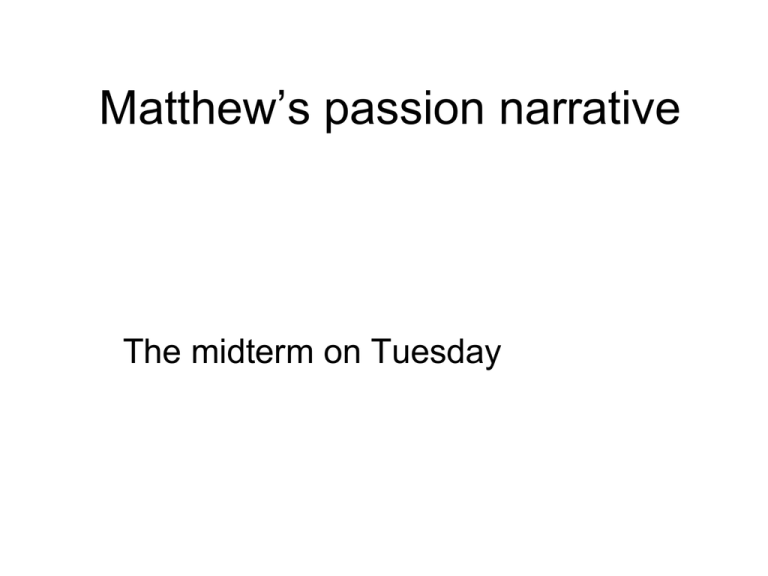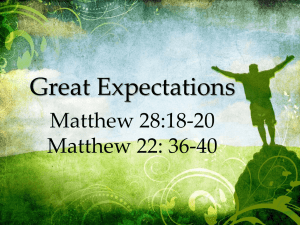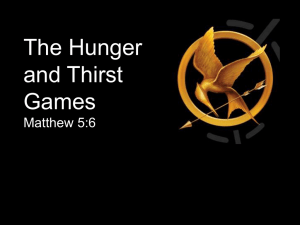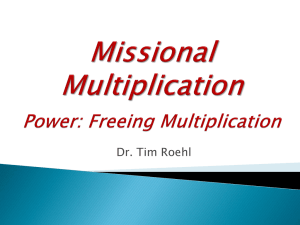Matthew`s passion narrative – third lecture
advertisement

Matthew’s passion narrative The midterm on Tuesday Later parables in Matthew • Parable of the Laborers: 20: 1-16. Paradoxical and challenging – its meaning? • The final sentence? • Another parable unique to Matthew: 21: 28-32, the two sons. • Parable of the vineyard: this in Mark, but Matthew adds vv. 43-45. • Parable of the dinner party (22:1-10): Matthew’s interpretation. • Parable of the wise and foolish virgins: 25: 1-13. • And the conclusion to the parable of the talents, 25: 30. A Q parable (Luke 19:11ff), but Matt gives it this ending. • The interpretive direction of these parables? Explicit provocation? Jesus’ equestrian feat in Matthew? • For Jesus’ triumphal (messianic) entry into Jerusalem, Mark had Jesus riding on a donkey -- implicit response to prophecy. • Matthew follows this, but makes prophecy explicit: 21:1-7 • And quotes the prophet Zechariah (9:9): “Tell the daughter of Zion, Look, your king is coming to you, humble, and mounted on a donkey, on a colt, the foal of a donkey.” • Donkey/colt is a doublet of Hebrew poetry. • But Matthew has the disciples bring both a donkey and a colt. • And Jesus rides both (21: 7)! • Indication of the significance Hebrew Scriptures had for Matthew – and his insistence on literal understanding of it. Woe to Scribes and Pharisees • Matthew includes a long passage of condemnation of scribes and Pharisees, 23: 136. • Mark’s passage, 12: 37-40, was comparatively brief and condemned only “the scribes.” • Some of this comes from Q, but Matthew has expanded it. • Again, the bitterness of the passage comes from the historical situation in the mid-80s, not predominantly from Jesus’ own preaching. Matthew’s vision of last judgment • Matt. 25: 31-46: a unique passage in this gospel. • Again, judgment and separation, but in ethical direction. • The body of Jesus is directed out to the future. • His body then existing in the hungry, thirsty, strangers, naked, sick, imprisoned. • Connects with teachings in Luke, though Luke does not contain this pericopé. • Which seems to confirm the ethical direction and force of the actual teachings of historical Jesus. Jesus’ arrest, execution – historically why it occurred • Synoptics and John all mention the incident in the Temple. • Caiaphas and Pilate vied for control of priestly vestments. • Under Caiaphas, the high priest, the market for sacrificial animals was now in Great Court of Temple. • Creating a massive dung problem! • Worshippers no longer able to put their hands on their sacrificial animal. • Pharisees opposed this change. • But it brought considerable profit to Caiaphas and Temple authorities. • So Jesus’ attack on the system was a provocation of major significance. • And this was doubtless what made him a major threat to Temple authorities. Passion narrative • • • • • • • • • • Matthew follows Mark’s narrative closely. But adds significant details: Caiaphas’ name (26:3). The 30 pieces of silver as the price of betrayal (26: 15). Judas’ question, “Is it I, Master?” and Jesus’ reply (26: 25). Jesus’ command to the one who drew the sword: 26: 5254. The necessity of fulfilling Scriptures. The death of Judas: 27: 3-10. Again, fulfillment of words of Scriptures (here Jeremiah). Dream of Pilate’s wife (27: 19). Pilate’s dramatic washing of his hands (27: 24). The earthquake (in addition to the darkness of eclipse in Mark) the tombs opening, rising of bodies of “the saints” and their appearance “to many.” More anti-Judaic elements in Matthew’s passion narrative • In response to Pilate’s claim: “I am innocent of this man’s blood”: • “And all the people answered, ‘His blood be on us and on our children’” (27:25). • The darkest and most tragic verse in the entire New Testament? (Now most often omitted in liturgical use of Matthew.) • The guard at the tomb: “the chief priests and Pharisees.” (27: 62-66). • And the bribery of the guard, and the story that “has been spread among the Jews to this day.” (28: 11-15). Matthew’s resurrection account • An earthquake and the descent of an angel (28: 2-4). • Compare the fragment of the Gospel of Peter. • The women react with fear, as in Mark – but now “and joy” added. • And they do tell the disciples – now the message does get through. (28: 8) • And Jesus appears to the women (28: 9-10). • Appearance to the disciples in Galilee on mountain: “Go therefore . . .” (28: 16-20). • “and make disciples of all nations . . .” The gentiles are now to be included. Concluding thoughts about Matthew • Paradox: very explicitly directed to Judaic audience. • But opens out to gentile world (“make disciples of all nations”). • And hostility and bitterness toward non-accepting Jews (result of historical circumstances late in first century). • Insistence on tying Jesus to scriptural traditions at crucial points (think of J’s equestrian feat!). • Strong sense of need for interior righteousness (Sermon on Mount) and ethical duty. • Strong sense of continuity between life of Jesus and later community: “I am with you.” (A contrast with Mark?) • The leadership explicitly passed to Peter and disciples. • A strong sense of “ekklesia,” a structured community, church.










